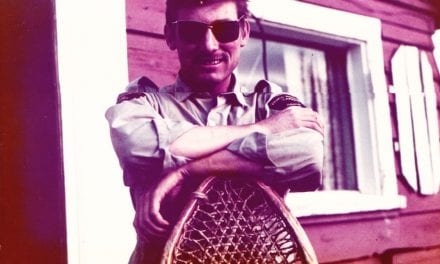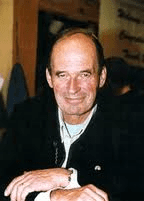(0:28:51) What are some of the more memorable events of your Parks career?
John – Being chased by the bear and that time Perry and I shot that bear that had run over Tim Auger. That was fairly exciting that day…there were two bears that day. They had to destroy two. That was at the old dump (on the Minnewanka Loop) before they closed it.
(0:30:41) John – Marie and I got spooked by that bear one time. He had a dead deer down by the crossing on Scalp Creek. We rode down there and the horses were having a drink of water. This thing was going “WOOF!” And anyway he came out and shook his head at us and we thundered out of there! We went back up the hill and gave him the trail. But, it turned out that was just guarding his dead deer.
(0:31:06) Marie – That had the potential to be really bad because that was at ten in the morning and then later at about four in the afternoon, these riders, a family and friends, were coming back from the water slide. There was a nice little waterslide, of polished rocks that people would slide over up Scalp Creek. They had ridden up and they saw the bear on the way up just off to their left and he didn’t do anything. So they rode up and when they were coming back they stopped to water their horses and I guess by this point the bear was getting more aggressive and he took a run at them as they crossed the creek. One lady said she lost her hat because they just tore out of there. They had kids riding double on bareback on some of the horses. I think that there were about six head of them. At about eight at night they thought that they better come and tell us about it. Well then we realized that the bear must have a kill there! We didn’t know when we saw it that it had a kill. We just thought well it’s there, likely passing through, and we are there and we are in his space, but then when we learned that the bear was there all day, “Oh, he had a kill.” So Johnny went down and taped the trail off and closed it. I phoned them (Fish and Wildlife) right away and told them that we had a problem with a bear. Really, Fish and Wildlife have to officially close it. So then after about four days they went back in there with a Fish and Wildlife officer and sure enough there was a spot where he had buried this deer. That could have had a bad outcome for people. The Fish and Wildlife officers always offered us great assistance and support when we were at the ranch.
For the record, is the Ya Ha Tinda federal land?
(0:32:36) Marie – It is our understanding that it is provincial land owned by the federal government.
(0:32:45) John – Yeah, Parks owned it. They have the surface rights and the province has the mineral rights.
(0:32:58) So that is why Fish & Wildlife would deal with those incidents and not the wardens?
Marie – Yes, it is actually provincial deeded land as opposed to federal land. It is not part of the national park. The Park owns the surface right and the Province manages the wildlife on the ranch. There is a little buffer of about a mile strip of land between the boundary of the park and the boundary of the Ya Ha Tinda. For some reason, political or logistical or legal maybe they left that there.
(0:33:18) John – At that time they thought it couldn’t be adjoined to the park or else it would be part of the park. Then it would have to be run like the park. So they did that.
I remember there was a reunion at the Ya Ha Tinda that you helped organize?
(0:33:46) Marie – There was the big one in 1997 that I helped to organize. Then there was another one in 2004. They were both really successful. We were living there for the 1997 one. We had left the year before the 2004 one, but we helped organize it and enjoyed the celebration. Then we helped organize the 100 year one.
Was working for the warden service important to you?
(0:34:26) Marie – Oh yeah. I always wished that maybe I had started with the park when we first went there because there was so much more interest. I realized it would have been more interesting to me than sitting in an office doing office work. Although I gained a lot of other skills doing what I did. But it would have been neat to have been out there, doing that.
What was it about working with the service that you enjoyed?
(0:35:00) John – I liked the mountains. Lots of times I went out with somebody to help them, well, with training the young guys. Lots of times I went with other wardens, just for a trip.
(0:35:18) Marie – That was something you didn’t mention about your duties at the start of the interview. You actually did the horse schools. After Neil Colgan had his accident they organized more in-depth training with the horses. (In 1979 warden Neil Colgan was kicked by his horse while on backcountry patrol. He died as a result of his injuries.) So John did that. That was where it started, which was huge. It was so important for them to get those skills.
When you were Barn Boss did the guys coming on have horse skills?
(0:35:52) John – Some of them didn’t. They run pretty good schools now, a lot better than what we did!
(0:36:11) Marie – They run them at the ranch too. When we were out there we did what we called an Advanced Horse School. Say the wardens had been in the backcountry for two or three years maybe, they would come in to learn about how the colts were trained and all that background stuff so when they took out a junior warden with them they could pass on a little more skills and information. Johnny would organize it, the program and stuff, but two horse trainers would do the actual hands on training. You did the packing and helped with the shoeing.
(0:36:49) John – But most of the time, I was busy doing something else. I handed most of it over to those guys.
Are there any legends about the Ya Ha Tinda that you could share?
(0:37:04) Marie – I was always fascinated myself by Nellie Murphy’s life out there. (Nellie Murphy lived at the Ya Ha Tinda for 15 years.)
(0:37:12) John – There was that musket ball. When they built the barn, they found a musket ball in one of the logs that had been harvested from the east side of the ranch. That may have been from David Thompson’s days. It could have been.
(0:37:24) Marie – When they were peeling that log and getting it ready to put it on the barn. She said it was embedded about eight inches into the log and she kept it. This is Nellie Murphy. She kept it for years and then eventually lost it. I always kept my eyes to the ground out there. I thought it might surface in the mud! I found this little tiny key one time, one of those really ancient old skeleton keys and it was right in front of the bunkhouse. I thought it was a flip top from a beer can and picked it up and here it was this neat little key which I put in the museum out there. It was fun to that (build the museum at the ranch). I just really got into that.

Frank Burstorm and John Nylund after installing the burled log display for the interpretive panels at the Ya Ha Tinda Ranch 1996. Photo courtesy of Don Mickle.
(0:38:00) John – There were the old teepee rings.
(0:38:06) Marie – All that cultural stuff and the history. Like Nellie had written her history in hopes of having it published. So when I read it, you could go to where she talked about and find these same places.
(Several years after Nellie passed away, her family published her story in a book “Incidents Along The Pathway of My Life, by Nellie Reviere Murphy.)
(0:38:13) John – There were these cairns. I don’t know who built the cairns out of rocks, but there are several of those out there. That could be from the David Thompson days too…
(0:38:38) Marie – They marked trails (with the cairns). The archeologists explained to me that they built a cairn on a height of land, like a little ridge and if they wanted to mark where to go they would go to the next height of land, build another cairn so whoever came could spot the cairns along the way and know that that is where the trail is. In the years where there was a lot of grazing, it would be grazed off really smoothly and you could follow these old depressions of trails that would go right out through Eagle Pass. Probably it was originally a buffalo trail, then probably the natives used it, then it was used by more people as they came in there and used that valley going through to the park. A lot of these cairns are located along those trails.
(0:39:23) Marie – Then John found one eagle hunting pit on the ranch. He found this big pit and questioned, “Why is this hole here?” He showed it to Peter Francis, the archeologist, and Peter realized “It is definitely man made.” But they weren’t sure what it was. I just happened to be reading David Thompson’s book and there was a quote right from his journal talking about traveling with the Peigan Indians and how they were hunting eagles. They talked about excavating a pit. They put willows and grass over top and they would sit in there with either a rodent tethered or a raw piece of meat. They would sit in there quite patiently and wait for the eagles. The eagles will sense the bait and then they will drop down to go after the meat or the rodent. The hunter would either kill the eagle, grab the legs and pummel them to death, or they will just take a feather. So there are seven of those pits! After we found the first one and he showed it to the archeologists and they could confirm it by doing their own research; we found others. Apparently this is a common thing that is still practiced in some first nations communities. Once we saw what the first one was then you would just accidently ride onto these things. They are always on a height of land. There is even one on Square Butte, down where Johnny grew up. There is a pit up there, so it is pretty neat. Yeah, I just happened to be reading that book when they were there! So I took it up and I said, “Here check out Sources of the River – Tracking David Thompson Across Western North America by Jack Nisbet, page 59. There it is!” Peter Francis researched it and confirmed that indeed this is how they hunted eagles.



